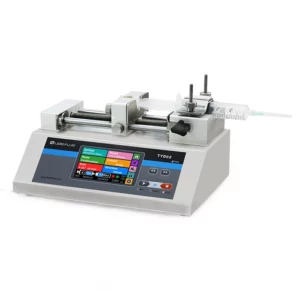How does the design of the gears contribute to the efficiency of a dual syringe pump?
In a dual syringe pump, the design of the gears plays a crucial role in determining the overall efficiency and performance of the pump.
The dual syringe pump typically consists of two syringes driven by a set of gears, and the design of these gears influences several aspects of the pump’s operation:
- Synchronization:
- The gears in a dual syringe pump need to be precisely designed to ensure synchronization between the two syringes. Proper synchronization is essential for accurate and consistent fluid delivery from both syringes, preventing any discrepancies in the pumping process.
- Precision and Accuracy:
- Gears with a high level of precision contribute to the accuracy of fluid delivery. The design should minimize backlash and play in the gear system, ensuring that the movement of the gears corresponds directly to the intended displacement of the syringes. This precision is crucial, especially in applications where accurate volumetric delivery is required.
- Smooth Operation:
- Well-designed gears contribute to smooth and continuous operation of the dual syringe pump. Smooth gear movement reduces friction, wear, and the likelihood of mechanical issues. It also ensures that the pump operates quietly without generating excessive noise.
- Minimization of Dead Volume:
- The gears should be designed to minimize dead volume within the pump system. Dead volume refers to the volume of fluid that remains within the syringe or pump tubing and doesn’t contribute to the dispensed volume. dual syringe pump Efficient gear design helps reduce dead volume, which is particularly important in applications requiring precise and minimal fluid handling.
- Material Selection:
- The choice of materials for the gears is critical for the overall efficiency and durability of the dual syringe pump. Gears made from materials with low friction coefficients and high wear resistance contribute to prolonged pump life and reliable performance.
- Maintenance and Longevity:
- A well-designed gear system facilitates ease of maintenance and contributes to the longevity of the pump. Gears should be resistant to wear and corrosion, and the design should allow for straightforward replacement if needed.
- Adjustability and Flexibility:
- Some dual syringe pumps may include features for adjusting the gear ratio or speed. A thoughtful gear design allows for such adjustments, providing flexibility in meeting diverse application requirements.
- Torque Transmission:
- The gear design should efficiently transmit torque from the motor to the syringes. This ensures that the pump can handle a range of fluids, including viscous liquids, without sacrificing performance.
- Resistance to Contamination:
- Gears should be designed to resist contamination by fluids being pumped. This is particularly important in applications where different fluids are processed consecutively to prevent cross-contamination.
- Temperature Stability:
- The gear design should account for temperature stability, ensuring that the pump operates reliably across a range of temperatures without compromising accuracy or performance.
The efficiency of a dual syringe pump depends on the synergy of various components, and the design of gears is a critical factor influencing the overall effectiveness of fluid delivery in applications such as laboratory experiments, medical infusion, or analytical processes.
